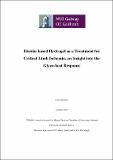| dc.contributor.advisor | Pandit, Abhay | |
| dc.contributor.author | Marsico, Grazia | |
| dc.date.accessioned | 2019-10-03T10:23:07Z | |
| dc.date.issued | 2019-10-01 | |
| dc.identifier.uri | http://hdl.handle.net/10379/15483 | |
| dc.description.abstract | Critical limb ischemia (CLI) is severe impairment of the microcirculation resulting in inflammation, ischaemic pain, non-healing ulcers and gangrene. Over 20% of patients have no option but to undergo a major limb amputation. Therefore, the need to develop new therapies is urgent. To this end, there are three important aspects to be taken in account: 1) to have a preclinical model that would mimic as closely as possible the pathological events associated to CLI; 2) to understand the molecular basis of the pathological events, 3) to provide extracellular matrix inputs to the damaged tissue to stimulate the formation of new blood vessels.
In the light of these considerations, this thesis has contributed to the field with a multidisciplinary approach. Firstly, a severe model of CLI was established and characterized in a wildtype mouse. The blood-flow recovery was severely impaired and histopathological features associated with ischemia - necrosis, inflammation, and spontaneous angiogenic response -were present. Secondly, this model was adopted to study the glycoenvironment modifications provoked by the ischemic insult. Among the biomolecules involved in the ischemic regeneration, glycans remain the least explored, despite their critical functional and structural roles. Although the role of glycans in mediating these pathological events has been reported, changes in the glycosignature following muscle ischemia remains poorly understood. Distinctive N-glycosylation modifications- increase of mannosidic species, alteration of sialylation type balance and reduction of hybrid and bisected glycans were identified. These modifications identified can serve as molecular targets and used when designing new therapeutic strategies. Finally, an Elastin-like hydrogel was tested for its potential modulation of the post-ischemic remodelling. Elastin is a natural protein present in the ECM that regulates specific cell pathways and mediates cell activities such as differentiation. Recently, Elastin-like recombinamers (ELRs) have demonstrated an angiogenic potential both in vitro and in vivo. The administration of an elastin-like recombinamers (ELRs) hydrogel was able to stimulate angiogenesis in a severe model of CLI. The hydrogel also induced the remodelling of ECM components towards the healthy state. N-glycosylation modulation were reported which suggested, in particular, the role of mannosylation and sialylation in mediating the healing effect.
This study suggests that the ELRs hydrogel is a promising clinical candidate for the treatment of CLI, and identifies glycosylation alterations as potential new therapeutic targets. | en_IE |
| dc.publisher | NUI Galway | |
| dc.rights | Attribution-NonCommercial-NoDerivs 3.0 Ireland | |
| dc.rights.uri | https://creativecommons.org/licenses/by-nc-nd/3.0/ie/ | |
| dc.subject | Elastin | en_IE |
| dc.subject | angiogenesis | en_IE |
| dc.subject | biomaterials | en_IE |
| dc.subject | Critical limb ischemia | en_IE |
| dc.subject | glycobiology | en_IE |
| dc.subject | Biomedical engineering | en_IE |
| dc.subject | Biomaterials | en_IE |
| dc.subject | Engineering and Informatics | en_IE |
| dc.subject | Physiology | en_IE |
| dc.title | Elastin-based hydrogel as a treatment for critical limb ischemia, an insight into the glyco-host response | en_IE |
| dc.type | Thesis | en |
| dc.contributor.funder | European Regional Development Fund | en_IE |
| dc.contributor.funder | Science Foundation Ireland | en_IE |
| dc.contributor.funder | Seventh Framework Programme | en_IE |
| dc.contributor.funder | DAAD Boehringer Ingelheim Fond Travel Grant | en_IE |
| dc.local.note | Critical Limb Ischemia (CLI) is a severe blockage of the blood vessels which markedly reduces blood flow to in the legs and progresses to the point of severe pain and even skin ulcers or sores. In this thesis, a severe animal model of CLI was developed. This model has been proven to mimic the diseases since it can to impair blood perfusion. This model has been used in the analysis of the sugar signature in ischemic tissues in the limb. An elastin biomaterial was also tested using the model and was shown to stimulate the growth of new blood vessel. The sugar- profile studies will be useful to gain a deep insight of the molecular mechanisms occurring at the different stages of the ischemia-reperfusion process and the effect of the elastin biomaterial. | en_IE |
| dc.description.embargo | 2020-10-01 | |
| dc.local.final | Yes | en_IE |
| dcterms.project | info:eu-repo/grantAgreement/SFI/SFI Research Centres/13/RC/2073/IE/C�RAM - Centre for Research in Medical Devices/ | en_IE |
| dcterms.project | info:eu-repo/grantAgreement/EC/FP7::SP3::PEOPLE/317304/EU/Development of Biomaterial-based Delivery Systems for Ischemic Conditions - An Integrated Pan-European Approach/ANGIOMATTRAIN | en_IE |
| nui.item.downloads | 235 | |


